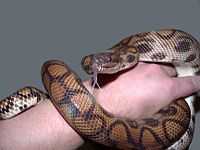Epicrates cenchria
| Epicrates cenchria | |
|---|---|
 | |
| Conservation status | |
| Scientific classification | |
| Kingdom: | Animalia |
| Phylum: | Chordata |
| Subphylum: | Vertebrata |
| Class: | Reptilia |
| Order: | Squamata |
| Suborder: | Serpentes |
| Family: | Boidae |
| Subfamily: | Boinae |
| Genus: | Epicrates |
| Species: | E. cenchria |
| Binomial name | |
| Epicrates cenchria (Linnaeus, 1758) | |
| Synonyms | |
| |
Epicrates cenchria is a boa species found in Central and South America. Common names include the rainbow boa,[2] and slender boa. A terrestrial species, it is known for its attractive iridescent sheen caused by structural coloration. Nine subspecies are currently recognized, including the nominate subspecies described here.[2]
Geographic range
Found in lower Central America in Costa Rica and Panama. In South America it occurs east of the Andes in Colombia, Venezuela, Trinidad and Tobago, Guyana, Suriname, French Guiana, Brazil, Ecuador, Peru, Bolivia, Paraguay and northern Argentina (in the provinces of Chaco, Córdoba, Corrientes, Formosa, Salta, Santiago del Estero and Tucumán). The type locality is Suriname.[1]
Habitat
Captivity
Despite requiring very specific humidity and heat this species is commonly found in the pet trade. During the 1980s and early 1990s, substantial numbers were exported from Suriname. Today, however, far fewer are exported and most offered for sale are captive bred.[3] Due to their need for high humidity in a captive environment, they should be considered of intermediate difficulty for snake owners, but as long as that is provided they can thrive in captivity. Younger specimens will often bite because of natural defensive instincts, but tend to calm down as they become used to handling.
Subspecies
| Subspecies[2] | Taxon author[2] | Common name | Geographic range |
|---|---|---|---|
| E. c. alvarezi | Abalos, Baez & Nader, 1964 | Argentine rainbow boa | |
| E. c. assisi | Machado, 1945 | Caatinga rainbow boa | |
| E. c. barbouri | Stull, 1938 | Marajo Island rainbow boa | |
| E. c. cenchria | (Linnaeus, 1758) | Brazilian rainbow boa | |
| E. c. crassus | (Cope, 1862) | Paraguayan rainbow boa | |
| E. c. gaigei | Stull, 1938 | Peruvian rainbow boa | |
| E. c. hygrophilus | Amaral, 1935 | Espirito Santo rainbow boa | |
| E. c. maurus | Gray, 1849 | Colombian rainbow boa | |
| E. c. polylepis | Amaral, 1935 | Central highland rainbow boa | |
Gallery
-

Peruvian species
-
See also
- List of boine species and subspecies
- Boinae by common name
- Boinae by taxonomic synonyms
References
- ↑ 1.0 1.1 McDiarmid RW, Campbell JA, Touré T. 1999. Snake Species of the World: A Taxonomic and Geographic Reference, vol. 1. Herpetologists' League. 511 pp. ISBN 1-893777-00-6 (series). ISBN 1-893777-01-4 (volume).
- ↑ 2.0 2.1 2.2 2.3 "Epicrates cenchria". Integrated Taxonomic Information System. Retrieved 10 July 2008.
- ↑ Brazilian Rainbow Boa at Smithsonian National Zoological Park. Accessed 12 November 2008.
External links
| Wikimedia Commons has media related to Epicrates cenchria. |
- Epicrates cenchria at the Reptarium.cz Reptile Database. Accessed 10 July 2008.
-
 "Aboma". Collier's New Encyclopedia. 1921.
"Aboma". Collier's New Encyclopedia. 1921.
